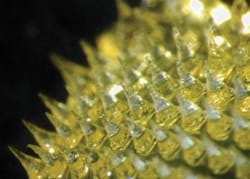RAMAN SPECTROSCOPY/DRUG TESTING: SERS will add real-time analysis to painless microneedle patch for drug testing
A bandage-like patch of polymer microneedles, paired with surface-enhanced Raman scattering (SERS), may enable a future method for safe and painless testing for drugs and some infections, along with real-time analysis.
Experiments conducted at the Queen's University Belfast laboratories of Ryan Donnelly, a researcher in the School of Pharmacy, are showing that the array of tiny polymer needles on the underside of the patch can absorb fluids in the skin's surface such as salts and fatty acids.
According to Donnelly, "we typically find the same compounds in this interstitial fluid as you would find in the blood. But compared with drawing blood, our patches can get their samples in a minimally invasive way. And it's far safer than using a conventional needle. These microneedles, once they have been used, become softened, so that there's no danger of dirty needles transferring infection to another patient or one of the healthcare workers." Two million healthcare workers are infected by needlestick injuries every year.
The microneedles are made of polymer gel. The backing material can be made chemically attractive to target compounds, encouraging them to diffuse into the gel with interstitial fluid drawn out of the skin and locking them in place for later analysis. Real-time monitoring might involve using SERS to detect drug compounds inside the gel. The group already has proof-of-concept for this idea and is now looking to extend the range of drug concentrations that can be detected in this manner.
The group is currently in discussions with a major medical manufacturer to produce prototype commercial devices, following the first stage of full clinical trials.


